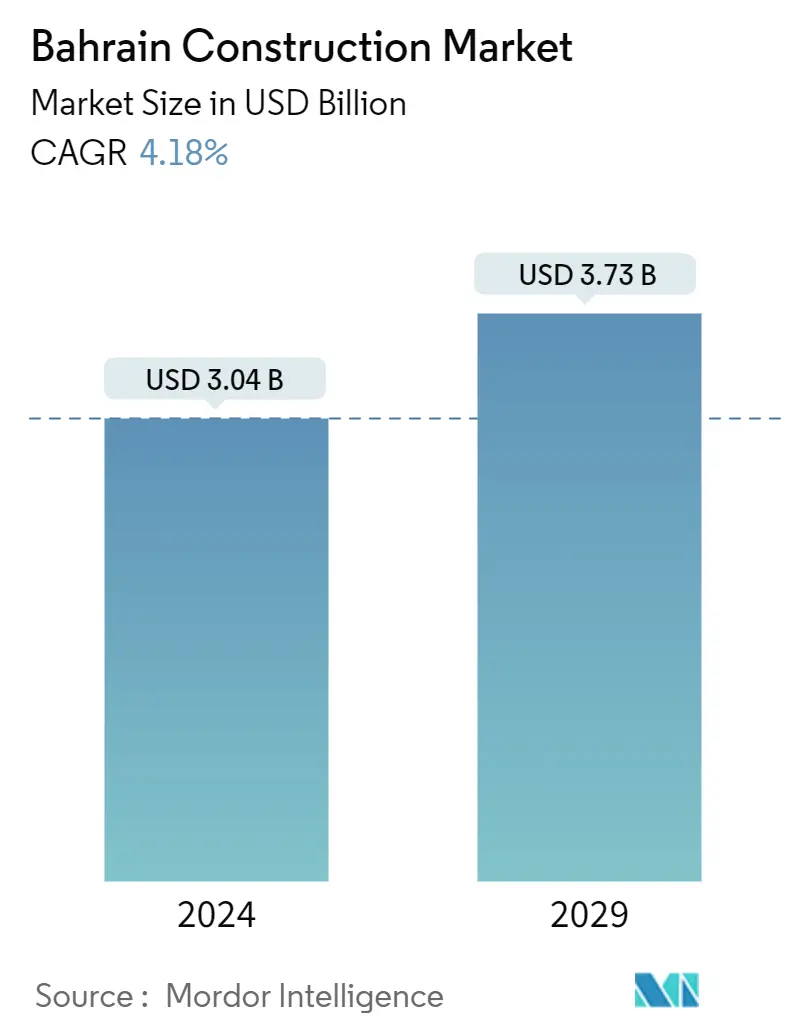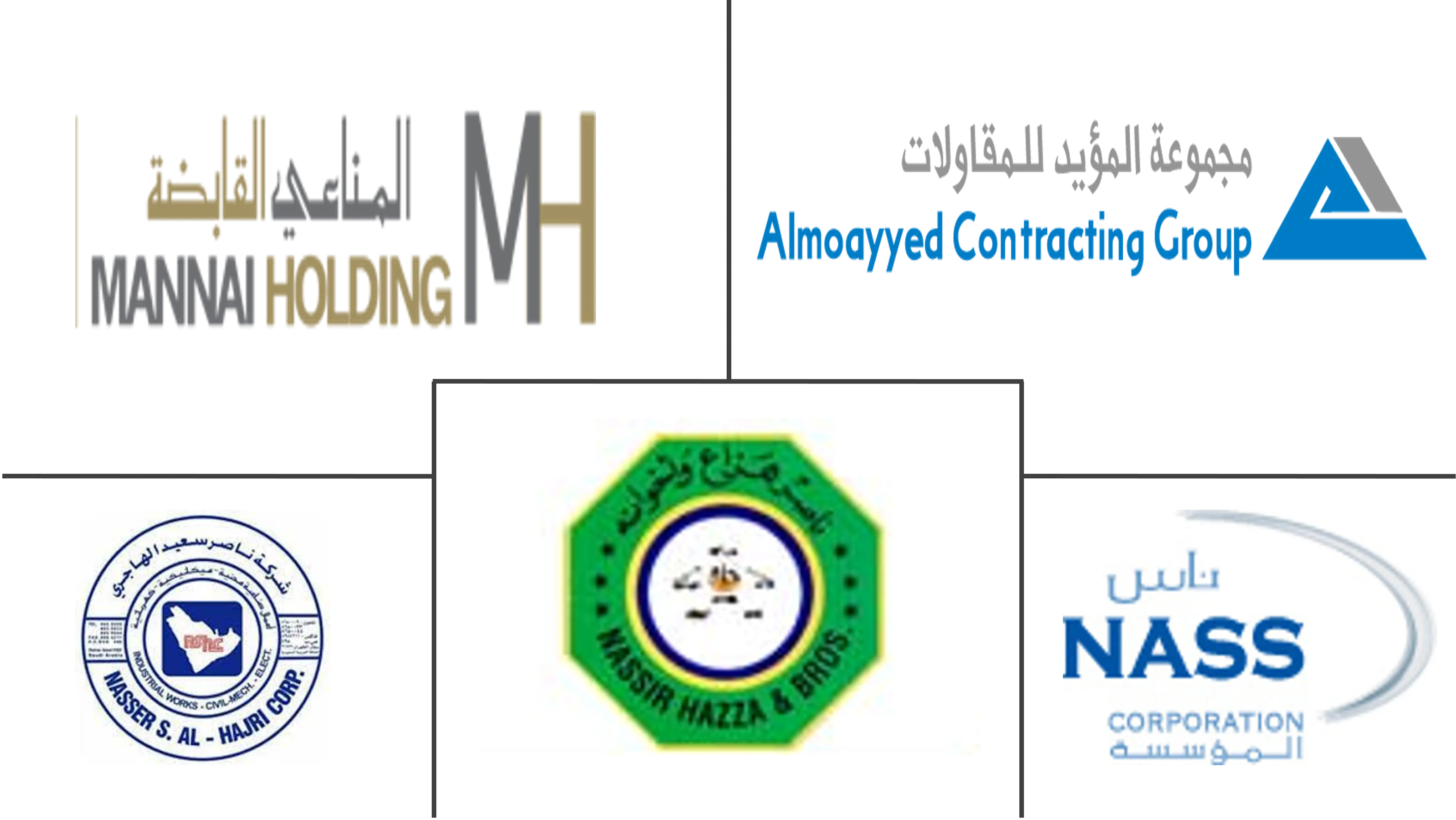Market Size of Bahrain Construction Industry

| Study Period | 2020-2029 |
| Base Year For Estimation | 2023 |
| Market Size (2024) | USD 3.04 Billion |
| Market Size (2029) | USD 3.73 Billion |
| CAGR (2024 - 2029) | 4.18 % |
| Market Concentration | Low |
Major Players
*Disclaimer: Major Players sorted in no particular order |
Bahrain Construction Market Analysis
The Bahrain Construction Market size is estimated at USD 3.04 billion in 2024, and is expected to reach USD 3.73 billion by 2029, growing at a CAGR of 4.18% during the forecast period (2024-2029).
- Strong government initiatives to invest in major construction projects are driving the market. Many labor market reforms backed by the economic development board may boost growth and improve productivity and output in the construction sector. Bahrain's construction industry shrunk in 2020 owing to the dual impact of the COVID-19 outbreak and a fall in oil prices. The cost of setting up and running a construction project in Bahrain is meager compared to other GCC countries. Bahrain is a ‘free zone,’ which allows 100% foreign ownership of the business and real estate and free movement of profits, capital, and dividends for the investors.
- In March 2021, the government released the budget for the Fiscal Years (FY) 2021-2022 (January 1, 2021, to December 31, 2022), which includes a project expenditure of BHD 600 million (USD1.6 billion) over the next two years. This includes allocations for projects in the infrastructure, housing, health, education, sports, culture, electricity, and water sectors, among others.
- Bahrain unveiled more than 22 critical infrastructure projects totaling more than USD 30 billion as part of its 2021 Economic Recovery Plan, including the creation of five artificial islands. Public-private partnerships model will be used to develop the majority of these projects. The Kingdom's Vision 2030 economic development strategy is congruent with the focus on construction that is being made. The strategy advocates diversification of the economy expanded privatization and industrialization, and training and education of Bahrain's national workforce to develop infrastructure, industry, housing, and connectivity.
- The process of project approval in Bahrain is very tedious and therefore discourages foreign companies from investing in construction projects here. Political instability threatens economic stability, thus adding more complications for foreign investors. Being an oil and gas-dependent economy, the price movements remain a source of risk as price changes affect every other sector, alarming foreign investors. Most of the labor and workers in Bahrain are unskilled, and the difficulty in obtaining visas discourages foreign labor.
Bahrain Construction Industry Segmentation
Construction is an industry that includes the erection, maintenance, and repair of buildings and other immobile structures and the building of roads and service facilities that have become integral parts of structures and are essential to their use. The Bahraini construction market report covers a complete analysis of the industry, including current economic and market scenarios, market size estimation for key segments, and emerging trends in the market segments. The report also covers the impact of the COVID-19 pandemic on the market.
The Bahrain Construction Market is Segmented by Sector (Commercial Construction, Residential Construction, Industrial Construction, Infrastructure [Transportation] Construction, and Energy and Utilities Construction). The report offers market size and forecasts for the Bahrain Construction market in value (USD) for all the above segments.
| By Sector | |
| Commercial Construction | |
| Residential Construction | |
| Industrial Construction | |
| Infrastructure (Transportation) Construction | |
| Energy and Utilities Construction |
Bahrain Construction Market Size Summary
The Bahrain construction industry is poised for growth, driven by robust government initiatives and strategic economic plans. The sector is benefiting from significant investments in infrastructure, housing, and various public services, as outlined in the government's budget and economic recovery plans. The Kingdom's Vision 2030 strategy emphasizes economic diversification, privatization, and industrialization, which aligns with the ongoing construction activities. Despite challenges such as political instability and a complex project approval process that may deter foreign investment, Bahrain's favorable regulatory environment, including 100% foreign ownership in free zones, continues to attract interest. The market is characterized by a mix of local and international players, with opportunities for small and medium enterprises to capitalize on the increasing government spending.
Bahrain's construction market is experiencing a transformation, with large-scale projects and urban development initiatives reshaping the landscape. The country's efforts to expand its landmass through reclamation projects and the development of artificial islands are responses to rapid urbanization and population growth. Major projects, such as the Tatweer Petroleum initiatives and the Marassi Al Bahrain urban project, highlight the sector's dynamism. Additionally, the upcoming metro network and greenfield airport project underscore the government's commitment to enhancing infrastructure. While the market remains competitive, the influx of private investment in tourism, transportation, and education infrastructure presents further growth opportunities, positioning Bahrain as a key player in the regional construction industry.
Bahrain Construction Market Size - Table of Contents
-
1. MARKET INSIGHTS AND DYNAMICS
-
1.1 Market Overview
-
1.2 Market Dynamics
-
1.2.1 Drivers
-
1.2.1.1 Focus on green buildings
-
1.2.1.2 Increased investment in infrastructure
-
-
1.2.2 Restraints
-
1.2.2.1 High value of construction material
-
-
1.2.3 Opportunities
-
1.2.3.1 Increased support from government rules and policies
-
-
-
1.3 Value Chain / Supply Chain Analysis
-
1.4 Industry Attractiveness - Porter's Five Forces Analysis
-
1.4.1 Bargaining Power of Suppliers
-
1.4.2 Bargaining Power of Consumers / Buyers
-
1.4.3 Threat of New Entrants
-
1.4.4 Threat of Substitute Products
-
1.4.5 Intensity of Competitive Rivalry
-
-
1.5 Technological Innovations in the Construction Sector
-
1.6 Impact of Government Regulations and Initiatives on the Industry
-
1.7 Impact of Covid-19 on the Market
-
-
2. MARKET SEGMENTATION
-
2.1 By Sector
-
2.1.1 Commercial Construction
-
2.1.2 Residential Construction
-
2.1.3 Industrial Construction
-
2.1.4 Infrastructure (Transportation) Construction
-
2.1.5 Energy and Utilities Construction
-
-
Bahrain Construction Market Size FAQs
How big is the Bahrain Construction Market?
The Bahrain Construction Market size is expected to reach USD 3.04 billion in 2024 and grow at a CAGR of 4.18% to reach USD 3.73 billion by 2029.
What is the current Bahrain Construction Market size?
In 2024, the Bahrain Construction Market size is expected to reach USD 3.04 billion.

